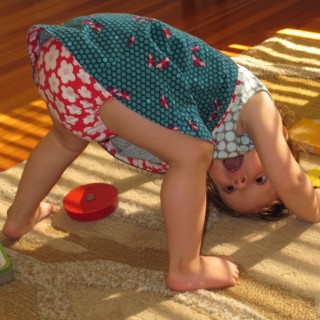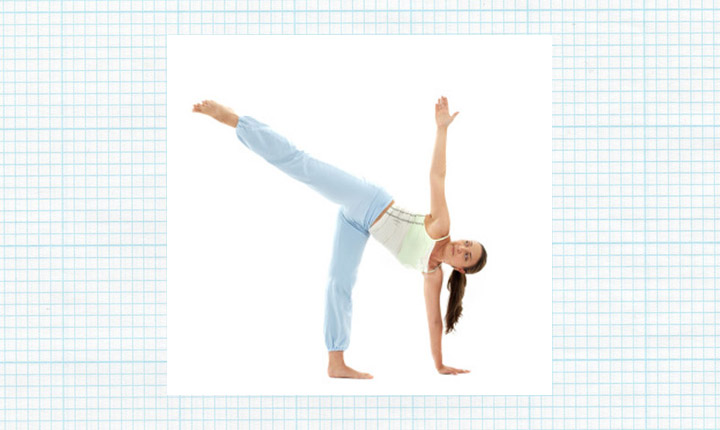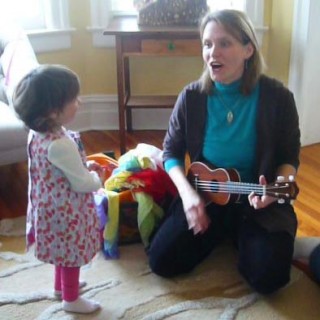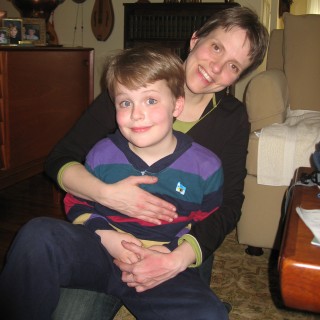The Longest Shortest Time
Doing Nothing = Something
When Sasha was six months old I enrolled her in a YMCA swim class that turned out to be taught by a woman who acted more like a high school coach than an instructor of babies.
“C’mon, Sasha, kick! Lemme see those legs move!” she’d bark. When met with a stony baby stare she’d chide, “Why so serious, Sasha?”
Duh, I’d think. You asked for it.
Our next swim teacher was much softer but she, too, was hot for those kicks. Evidence that Sasha was absorbing her instructions as, it seemed, every other toddler in the class was. Sasha would kick like crazy in the bathtub but in the pool her legs were dead weights. I explained this to the teacher and told her than Sasha wasn’t one to perform in a group setting.
The teacher let out an exaggerated laugh. “She’ll do great in school!”
Deep down, I am not really concerned with whether or not Sasha does what she’s “supposed to” do in Mommy and Me classes. But after awhile it gets hard to consistently have the only kid in the class who doesn’t participate. Was there some truth to the swim teacher’s school comment? Nah, I told myself. Still, I was a little bit shaken.

This session we took a break from swimming and joined a yoga class. I figured it would be a good fit because the weird positions Sasha often hangs out in for fun actually have yoga names. But it’s the same thing there. Sasha sits still—breathtakingly still—through each and every pose the teacher models. All of the other kids perform some version of the pose—even the little one-year-old who is only recently bipedal. At the end of class the (sweet and well-meaning) teacher gives each kid a block, ushers them to the wall, and coaxes them into Half Moon Pose. In case you’re unfamiliar, here’s what it looks like:

yogapostures.com
Now, I don’t care *at all* if Sasha can do Half Moon. Now or ever. But for some reason on the first day I found myself echoing the teacher when she came around to us: C’mon, Sasha. Put your hand here . . . your arm here . . . your leg [yank] up. Yes. I actually manually pinned her limbs in the right places. I felt terrible about it. I guess my anxiety levels were peaking. From yoga.
The one place where I don’t ever feel bad about how little Sasha does in class is music. That’s entirely because of our teacher, Anne Sailer. You may remember Anne from episode 1—the music teacher whose son hated lullabies—and this post about filling in the blanks in songs. From the very start, Anne told me not to worry whether Sasha did anything. “No matter what she does,” she said, “you know that Sasha is having an intensely powerful musical experience, right?” I took her word for it and I’m so glad that I did because music is Sasha’s favorite part of her week. Mine too.
Recently I told Anne about the anxiety I was having over our other activities and she reminded me of her “powerful musical experience” line.
“But how do you know?” I pleaded.
“I have research on my side,” she said.
So I asked Anne to share her POV on the subject of doing and not-doing, to point us to some of that handy research—and maybe, just maybe, give us parents one less thing to worry about. Without further ado, here’s Anne.
+++
In every Music Together class I teach, some of the children spend the class doing something that, quite frankly, looks like they’re doing nothing: sitting and watching. In one class this week, while we were playing with egg shakers, half the children sat quietly holding their eggs and observing while the other half joined the grown-ups in shaking up a storm. Parents of the observing children often worry that their kids aren’t engaged, aren’t learning, or don’t like music. But most likely just the opposite is true. Children need a lot of time to absorb a new activity, experience, or concept before they can play with it, experiment with it, and actively join in. In fact, being an observer is an actual stage of play that has been identified by child development researchers.
One of those researchers—a sociologist named Mildred Parten—coined the term onlooker stage when she developed a classification system for children’s play in 1932. That term is still used by researchers today, like Sarah Jane Anderson. Anderson, a professor of child development, writes in the National Association for the Education of Young Children journal Young Children that engaging in play activity as an onlooker “offers children opportunities to mentally manipulate what they see and hear, organizing and integrating information and storing it away for future use. The children may actually be mentally placing themselves into a situation they are observing, and testing how they might respond if they were involved.” In other words, onlooker children are practicing in their heads what they see others doing in class—the same way we might behave on the first day of a new aerobics class.
All children engage in the onlooker stage. But then why are some doing while others are observing? That’s because some children need to spend only a few moments as an onlooker before, say, shaking eggs, while others might need to spend days—or weeks!—in this stage before joining in. A child might be also be more of an onlooker in one activity than another—for example, she might be more likely to join right in in group jumping but sit silently during every single instrument jam session.

Anne and Sasha
Once children have spent enough time as onlookers they are ready to engage outwardly in play. That outward engagement may happen in class, but it’s more likely to be at home. A colleague of mine once said, “It’s like the children are ON RECORD in class and then PRESS PLAY when they get home.” That’s it exactly. Almost weekly a parent or caregiver will come up to me and say, “I know he doesn’t do anything here in class, but he does so much at home.” One little boy surprised his mother, after a morning of quietly watching the rest of the class dance around waving scarves, when he absconded with a dish towel singing “doo-doo-dooo!” at the top of his lungs. Another mom caught her daughter, who never banged on a thing in class, pulling pot lids off a shelf she could barely reach and turning them into cymbals. Sometimes I do see this sort of turnaround in class, too—like the two-year-old who starts waltzing by rocking from side to side, after watching the adults do the grown-up waltz for a few weeks. It’s important to remember, though, like I told Hillary, that even if children continue to simply observe they are still having a powerful experience, no matter what the activity.
I wish I had known this when my daughter was on the soccer field. While the other four-year-olds were kicking balls and running around, she chose to use her ball as a stool while she sat and watched. Unaware of all the onlooker-stage-of-play stuff, I said encouraging things like, “Don’t you want to play?” Or, “Why don’t you kick the ball to me?” The coaches, too, tried to motivate her to get in the mix. “Come on and join us—it’s fun!” Or, “Hey, don’t just sit there!”
Instead of increasing the likelihood of my daughter learning, our pleas for involvement actually interrupted her learning. In their book The Play’s the Thing: Teachers’ Roles in Children’s Play, Elizabeth Jones and Gretchen Reynolds demonstrate that well-meaning adults, intending to enhance children’s play through encouragement or injecting ideas, often derail the play (and therefore the learning) altogether. Children intuitively understand that play is their job and will frequently stop playing the minute an adult intrudes (unless the child herself has invited the adult to play). No wonder my daughter quit soccer at age four and has never wanted to set foot on a soccer field again!
The good news is, there are things you can do to honor your child’s learning process and her stopover in the onlooker stage of play. Here are some techniques I wish I had had employed back when my kids were little:
- Become an observer yourself. Watch your child as she is watching, and observe what she is observing. You will be joining her in a kind of “onlooker solidarity.”
- Resist the urge to leap to conclusions. It’s natural for parents to project what they think (or fear) their children are doing (or not doing). Take a breath and let your child show you what’s truly going on.
- Engage in your own way, modeling joyful involvement. Realize that your child is also watching you and how you respond to and engage in the activity. The more happily you play and join in, the more she will learn as she’s observing. (For example, when a child watches her parent sing, she is learning to sing even if she is not making a sound.)
- Talk to the teacher. It’s sometimes hard to know what to say to a teacher who’s trying hard to please you but isn’t understanding your child. The best strategy might be to try a proactive approach: Talk to the teacher before the class starts and let her know that your child is an observer, that your child will likely “do” very little in class, and that pressure to join in before your child is ready will likely backfire. You can also share with the teacher how your child does downward dog all day long at home—letting them know that your child is getting something out of the class no matter how little she participates.
It makes sense to me that I see a lot of onlookers in my music classes. Music involves, among other things: pitch, beat, melody, harmony, rhythm, meter, phrasing, timing, turn-taking, coordination, prediction, and community interaction. With all that input, it’s amazing that they do anything in class at all!
If you support your child’s need to be an onlooker, one day you might walk into the kitchen to find her dancing with a dishtowel or crashing together pot lids and realize that all that ON RECORD time gave her wonderful input to fool around with when she was finally ready to PRESS PLAY.
+++
Hillary here again. I am so grateful to Anne for sharing her knowledge with us on LST. Thank you, Anne!
Please share your experiences with your own little observers in the comments. If you have any questions for Anne, I’ll direct her attention to them. Also be sure to check out Spin and Stop, Anne’s enlightening blog about music and learning in early childhood.
Upside-down photo: Richard Frank
The Longest Shortest Time may earn a small commission from products linked on this site. Using our affiliate links helps support our work.
